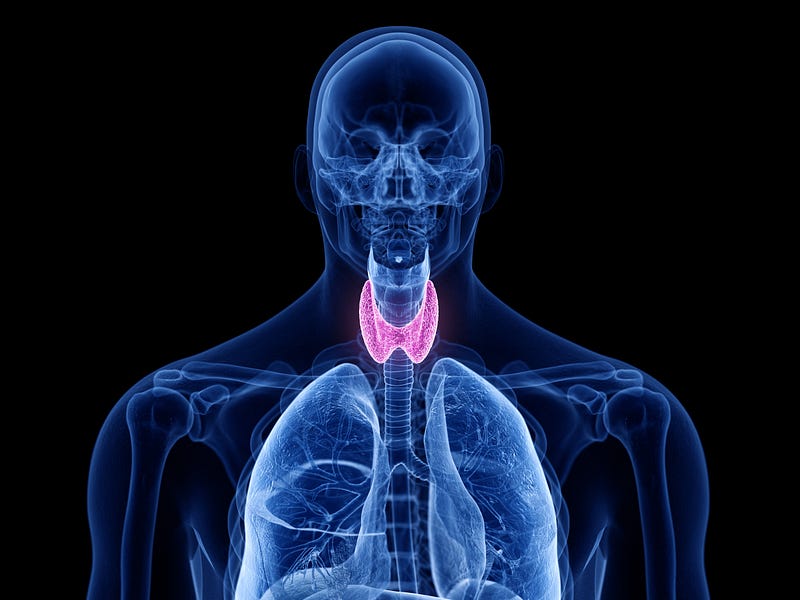The Impact of COVID-19 on Thyroid Health: What You Need to Know
Written on
Chapter 1: Introduction to COVID-19 and Thyroid Function
The emergence of COVID-19 has raised concerns regarding its effects on various organs, including the thyroid. Early research indicates that this butterfly-shaped gland, located at the base of the throat, may be impacted by the virus. At the Ca’ Granda Main Polyclinic Hospital in Milan, medical professionals began investigating this possibility as they routinely monitor thyroid-stimulating hormone (TSH) levels in critical care patients. Dr. Ilaria Muller, an endocrinologist at the hospital, compared thyroid hormone levels in COVID-19 patients with those from the previous year to identify any significant changes.
Section 1.1: The Role of the Thyroid Gland
The thyroid plays a vital role in various bodily functions, regulating metabolism, fertility, and digestion. Disruption of its function can lead to numerous symptoms, including weight gain, cognitive difficulties, and even an increased risk of miscarriage or heart disease.
Subsection 1.1.1: Research Findings on Thyroid Dysfunction
After excluding individuals with preexisting thyroid disorders, Muller and her team analyzed data from 85 COVID-19 patients treated in March and April of this year. This was compared to 78 patients admitted during the same months in 2019. Their findings, published on July 30 in the Lancet Diabetes & Endocrinology journal, revealed that approximately 15% of COVID-19 patients exhibited thyrotoxicosis, an excess of thyroid hormones in the bloodstream. In contrast, only one patient from the 2019 cohort showed signs of this condition.

Section 1.2: The Connection Between COVID-19 and Thyroiditis
Researchers suspect that COVID-19 could trigger a rare form of thyroiditis characterized by inflammation that may lead to thyrotoxicosis. Though viral thyroiditis remains somewhat enigmatic, it has been associated with various viruses, including influenza and hepatitis. Dr. Muller emphasizes that since many viruses can affect the thyroid, SARS-CoV-2 could be another potential culprit.
Chapter 2: Clinical Observations and Recommendations
The first video discusses the relationship between SARS-CoV-2 infection and thyroid dysfunction, highlighting the need for awareness among healthcare professionals regarding potential thyroid issues in COVID-19 patients.
Curiously, the COVID-19 patients with thyrotoxicosis exhibited elevated thyroxine levels without the usual increase in triiodothyronine associated with viral thyroiditis. They also reported no neck discomfort, a common symptom of thyroiditis.
In severe cases, the virus may invade the thyroid, but this occurrence seems rare in mild infections. Among 41 patients receiving low-intensity care, only one showed signs of thyrotoxicosis.
Emerging evidence from various studies supports the notion that COVID-19 may disrupt thyroid hormone levels. A recent study involving nearly 300 COVID-19 patients found thyrotoxicosis in about 20% of participants, particularly among those exhibiting systemic inflammation.
The second video addresses natural treatments for thyroid issues, emphasizing the importance of recognizing warning signs and promoting longevity.
Dr. Gherardo Mazziotti, who led the aforementioned study, suggests that while the thyroiditis induced by SARS-CoV-2 may be temporary, it could also lead to chronic thyroid dysfunction in some patients. Follow-up ultrasounds conducted on COVID-19 patients indicated abnormalities, raising concerns about potential cell damage in the thyroid.
Given these findings, it is crucial for healthcare providers to monitor COVID-19 patients for thyroid-related symptoms and to conduct blood tests as needed. Preliminary data indicate that preexisting thyroid conditions do not increase the risk of severe COVID-19.
As research continues, it is vital for physicians to remain vigilant regarding the potential thyroid implications of COVID-19, particularly in patients exhibiting nonspecific symptoms like rapid heart rate or hair loss, which could suggest underlying thyroid dysfunction.